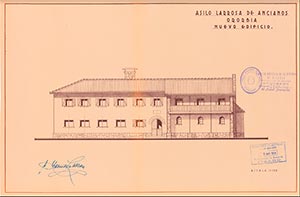Cultural heritage of Ororbia
St. Joseph's Asylum (Larrosa Foundation)
On the road to Ibero stands the old San José asylum, a charitable establishment founded by José Larrosa y Romeo in 1902 for attend to "poor men disabled in the work", with preference for residents or natives of Echauri, Ororbia and Villava. The founder, a wealthy merchant who was a member of the committee administration of credit Navarro, bequeathed his house and estate in Ororbia, as well as a sum of ninety thousand pesetas. Several religious orders succeeded one another in the government of the asylum, which added the teaching of girls and infants to the original welfare mission. The Daughters of the Cross did it for the longest time, between 1911 and 1960.
Nothing remains of the first building that housed the asylum, as it was attacked by a plague of termites that forced the construction of a new one. The nuns were able to count on the financial support of the Council, which lent them fifty thousand pesetas on advantageous terms, partnership . position The project, dated 1958, was the responsibility of a grandson of the founder, the renowned architect José Yárnoz Larrosa (1884-1966). His career included the restoration of the castle of Olite and the extension of the Palacio de la Diputación de Navarra -both at partnership with his brother Javier, who went into exile after the Civil War-, the monument to the Fallen, the church of San Miguel and the high school de la place de la Cruz in Pamplona, and the headquarters of the Bank of Spain in several cities, including Pamplona. The Ororbia asylum is a minor work that departs from the monumental classicism displayed by Yárnoz in most of his works.
The new building replicated the layout of the previous one, although in a location further away from the river so as not to expose it to flooding. On the leave floor were the classrooms and the chapel with its sacristy, and on the first floor, the nuns' quarters, the dining room, the kitchen, the infirmary and a large dormitory for the elderly. The elevation exhibits a large horizontal development with an access door in the central part. It stands out for its sobriety, only broken, as can be seen in the original plan of the south façade, by the sunny gallery for the sick, supported by two abutments that in turn delimit the area of the chapel.
ALEGRÍA SUESCUN, D., Flour Mills of Ororbia. Historical-documental study, Concejo de Ororbia, 2015.
GUIJARRO SALVADOR, P., Ororbia: a thousand years of history, Concejo de Ororbia, Kybse, 2015.
MARTÍNEZ ÁLAVA, C. J., TARIFA CASTILLA, M.ª J. and LATORRE ZUBIRI, J., La iglesia de San Julián de Ororbia. History and restoration, Concejo de Ororbia. Foundation for the Conservation of the Historical Heritage of Navarre. Graftech Ibérica, 2014.
ZUBIAUR CARREÑO, F. J., "Catalog de miradas. La Navarra que fotografió Nicolás Ardanaz", in Ricardo Fernández Gracia (coord.), Pvlchrvm: Scripta varia in honorem M.ª Concepción García Gainza, Gobierno de Navarra. University of Navarra, 2011, pp. 838-846.
transcript del Asilo San José: file Contemporáneo de Navarra/Vivienda/1116846.











